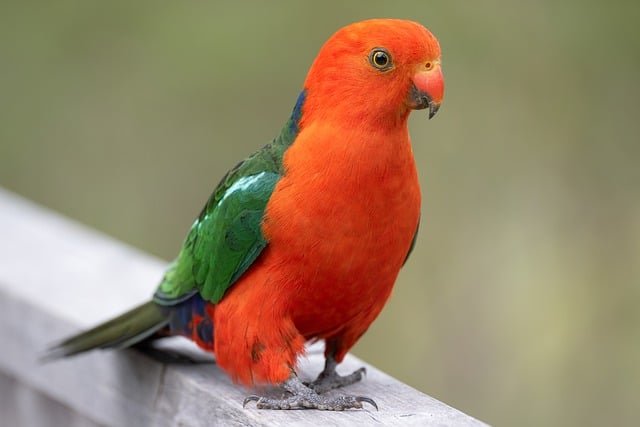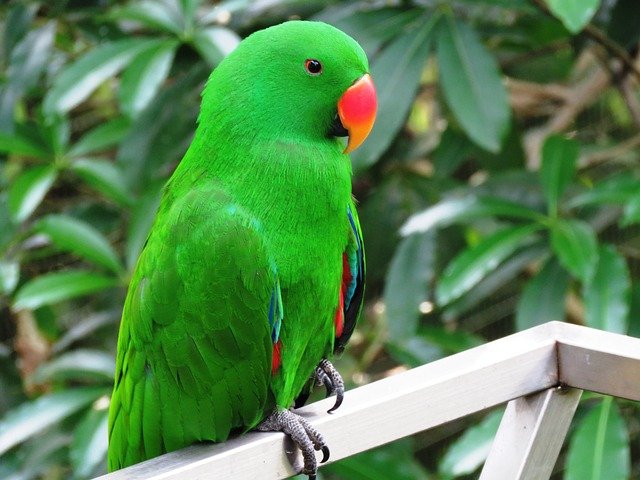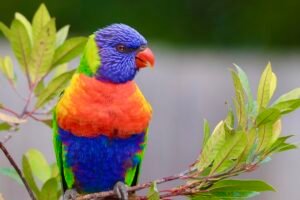There’s a fascinating diversity of feather colors in parrots. From the rose-colored breast on a Galah Cockatoo to the entire spectrum of rainbow colors on a Lorikeet. Each species of parrot has a distinct set of colors which give it its unique identity. But how are they able to make these colors?
Most of the feather colors are produced by pigments that are deposited into the feathers when they’re growing. All parrots produce a pigment called melanin which is responsible for making dark-tone colors like black, brown, and gray.
The rest of the colors are obtained from Psittacofulvins, a pigment unique to parrots only. It is synthesized locally by parrots and gives rise to bright colors like red, yellow, and orange.
However, not all colors are produced naturally by parrots. Parrots cannot produce a blue pigment, In fact, only a few animals in nature are capable of naturally creating true blue pigments.
But parrots have evolved to work their way around this by changing their feather structure. As we all know, when you mix two colors, you get an entirely new color. The arrangement of different feathers works quite the same way.
The workings of a parrot’s feather coloration are intriguing as you know more about them. Let’s dive deeper into understanding what goes into making feather colors and how their arrangement gives rise to new colors.
Quick Navigation
How Does Feather Coloration Work In Parrots?

Pigments
Parrots essentially get most of their colors from pigments. Certain pigments are made by the cells in the body while others they need to get from the foods they eat. Melanin and Psittacofulvins are mainly synthesized in the parrot’s body. They are also the ones that create the majority of the feather colors.
Melanin
Melanin is perhaps the most well-known color compound found across all animal species. These compounds make up dark colors like brown, black, gray, and also certain pale shades of red and yellow.
Psittacofulvins
For a long time, not much was known about how parrots use pigments in their feathers. It was only recently discovered that parrots use a special pigment that is specific to them called Psittacofulvins.
In a study published by Current Biology, bright colors such as red, yellow, and green commonly seen in parrots exist because of Psittacofulvins. However, like most birds, parrots cannot produce a green pigment and use a combination of natural pigments and the structural arrangement of feathers to create it.
Carotenoids
There’s another pigment found in parrots and across all species of birds called carotenoids. However, unlike other birds, parrots do not use this pigment for the formation of colors on their feathers.
A study published by Comparative Biochemistry and Physiology observed high concentrations of carotenoids in the parrot’s bloodstream during the time of feather growth, even though it is not applied to the feathers.
However, this does not mean that carotenoids don’t play a role in feather growth in parrots. Beta carotene which is part of the class of carotenoids acts as a precursor to Vitamin A, a nutrient essential for various biological processes in parrots.
Structural Arrangement
Pigments are what naturally apply colors to the feathers but the structural arrangement of the feathers is where the trick happens.
According to the Journal of the Royal Society Interface feathers contain light-reflecting structures called melanosomes. These are very tiny bubbles of the pigment melanin that are spread throughout the feather in an intricate layout.
They produce different colors by selectively absorbing and reflecting light at specific wavelengths using melanin. This means that the blue color you see on a Blue and Golden Macaw is actually dark grey which is reflecting light at specific wavelengths to make it look blue.
Another way feathers get their colors is through structural coloration. Structural coloration produces colors through the scattering of light using nanostructure arrangements of feather proteins and/or the melanosomes on them.
The size of the air bubbles and the intricacies of the feather greatly influence the actual colors that appear in front of our eyes.

Why Are Parrots Colorful?
The reason why parrots are so colorful is not purely biological. The vibrant and unique plumage of parrots serves various other purposes for them in nature. Let us understand the reason behind the staggering hues of parrots.
Courtship
Male parrots tend to be more colorful than females. This is because males often have to compete with other parrots to get the attention of their desired female.
Being more colorful can be seen as a sign of virility in male parrots and helps to catch the attention of females. Besides, dull and distressed-looking feathers often mean the parrot is sick, making them an unsuitable candidate for mating in the eyes of female birds.
Camouflage
You might think the bright and varied colors of parrots can make them easy to spot by predators. But the fact is, most of the colors we see on parrots are really just a trick of their feathers.
It is an effective use of the Tyndall Effect, which are color variations created by the scattering of light. Parrots are masters of their habitat and know how to use their surroundings to their benefit.
Also, parrots that have dull and poor-quality feathers often become easy targets for predators in the wild. Distressed feathers are typically caused by illnesses in parrots which their predators can sense once they are no longer able to conceal their weakness.
Having bright and shiny feathers helps parrots protect themselves from dangers and even assert their dominance in certain situations, like defending their territory or intimidating an intruder.
Identification
The distinct color of plumage also helps parrots identify the members of their species and know where their flock is. It is just like the saying goes “Birds of a feather flock together”. Parrots like to be with their flock because it helps them be more secure and helps them avoid predators.
Communication
We know parrots are intelligent birds that communicate with all sorts of body language clues and vocalizations. But sometimes they also use their feather colors as a way to express their emotions.
Macaws have the ability to turn their cheeks pink or red looking as though they’re blushing. Sometimes they may also fluff up their facial and neck feathers to communicate with their owners.

Can A Parrot’s Feathers Change Color?
A parrot’s plumage shouldn’t normally change color after its first molt. However, certain conditions can affect how the feathers look and even cause a change in coloration. Let’s look at some of the reasons why parrots’ feathers change color:
Damaged Follicles
Feathers are initially colorless. As they grow out of the bird, they are applied with the pigments that give them their original colors. But during this process, if any of the feathers sustain damage either on the shaft of the feather or the follicle itself, they may not be able to produce their true colors.
This is because when the feathers are growing, they are supplied with pigments via the bloodstream. Whereas a solid structure of the feather is needed to disperse light in a manner that it is able to perfectly absorb and reflect light.
Stress
Exposure to stress for a long time can form black-colored bands across the feathers known as stress bars. These may appear as dark lines and often make the feathers look less colorful.
Stress bars are an indication that the parrot is unwell. You cannot know what health issues the parrot might be facing but can give you hints about the possible causes of sickness.
Poor Nutrition
Changes in feather coloration may also occur if the bird has been fed a high-fat diet for too long. Dietary issues are the most common cause of liver problems in parrots and solving this problem can start by changing their diet.
A parrot’s diet should include high-quality pellets, some fruits, vegetables, and grains. All varieties of seeds should be avoided as they offer little nutritional value and contain high amounts of fats.
Sickness
Various illnesses can also affect how a feather looks and feels. Parrots that are sick undergo changes in their feathers. During certain health conditions like liver disease, a parrot’s feather can change in color and develop dark patches.







